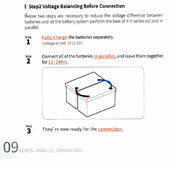TomPanning
New Member
As described in this post, my dad has a 24V system for his RV using 12V Litime batteries in a 2s2p configuration. A couple months ago, he had a problem where both the series got out of balance. We removed the batteries and tried balancing, but the "low" batteries from both series wouldn't take a charge, either in a passive balancing configuration or being attached directly to a Litime 12V charger. He's working on getting the two bad batteries replaced by LiTime.
In the meantime, we put the two good batteries in a series and added an active balancer. We tested the system on Thursday, running the air conditioner from the inverter, and charging the batteries using a generator and the 1600 watts of solar on his RV roof. After finishing charging, the two batteries were reading 13.62V and 13.38V (measured with the battery disconnect switch off so that there was no load or charging), but then we ran the air conditioner long enough for the shunt to record 4 aH consumed and re-measured the batteries, and they were 13.36 V and 13.38 V, so we felt like the balancer was doing its job.
However, after camping for a night (with electric hookup), they tested the batteries by disconnecting from the campground power and the inverter wouldn't run the air conditioner. When they got home, we checked and with no load/charge (using the battery disconnect switch) the batteries read 13.4V and 13.2V. BUT when the battery disconnect switch was turned on and the shunt reported a 0.4 amp draw, the battery that had previously been 13.2V dropped to 12.2 volts. Even worse, when the inverter tried to turn on (no active load on the inverter, just the inverter trying to turn on) that battery's voltage dropped below 10 volts.
So with now 3 of 4 batteries seemingly dead (all of them were purchased less than a year ago), we're trying to figure out if something in the system could be killing them? We had already checked that all the connections were tight when the first two batteries started acting up. Is there anything else we should be checking?
In the meantime, we put the two good batteries in a series and added an active balancer. We tested the system on Thursday, running the air conditioner from the inverter, and charging the batteries using a generator and the 1600 watts of solar on his RV roof. After finishing charging, the two batteries were reading 13.62V and 13.38V (measured with the battery disconnect switch off so that there was no load or charging), but then we ran the air conditioner long enough for the shunt to record 4 aH consumed and re-measured the batteries, and they were 13.36 V and 13.38 V, so we felt like the balancer was doing its job.
However, after camping for a night (with electric hookup), they tested the batteries by disconnecting from the campground power and the inverter wouldn't run the air conditioner. When they got home, we checked and with no load/charge (using the battery disconnect switch) the batteries read 13.4V and 13.2V. BUT when the battery disconnect switch was turned on and the shunt reported a 0.4 amp draw, the battery that had previously been 13.2V dropped to 12.2 volts. Even worse, when the inverter tried to turn on (no active load on the inverter, just the inverter trying to turn on) that battery's voltage dropped below 10 volts.
So with now 3 of 4 batteries seemingly dead (all of them were purchased less than a year ago), we're trying to figure out if something in the system could be killing them? We had already checked that all the connections were tight when the first two batteries started acting up. Is there anything else we should be checking?



